Thursday, December 30, 2004
TSUNAMI RELIEF
 Swirling ocean swells are seen along the flooded coast Sri Lanka in an image taken by DigitalGlobe's QuickBird satellite shortly after the area was hit by a Tsunami on December 26, 2004.
Swirling ocean swells are seen along the flooded coast Sri Lanka in an image taken by DigitalGlobe's QuickBird satellite shortly after the area was hit by a Tsunami on December 26, 2004.
The recent tsunamis have created a disaster of staggering human proportions. It is a deeply tragic situation. You can help by donating to the agency of your choice. One possibility is the Amercian Red Cross. If you have an Amazon.com account, you can go to Amazon and use your credit card to donate to the American Red Cross.
Google.com has several ways to donate to help with Tsunami Relief.
However you decide to give, it is important that you give.
American Red Cross Disaster Relief (from the Amazon.com website):
At least 120,000 people have lost their lives in East Africa and South Asia in the aftermath of the earthquake and resulting tsunamis on December 26. Thousands of people in Sri Lanka, India, Thailand, and Indonesia are still missing; many others have lost their homes and livelihoods. Sri Lanka and Indonesia suffered the highest number of deaths, but India, East Africa, Seychelles, Maldives, and Thailand were all affected by the tsunami waves, which reached as high as 20 feet. Aid workers and volunteers are focused on stopping the spread of disease and delivering food and drinking water to survivors. The American Red Cross reports that emergency assessment and first-aid teams were on the ground quickly and are already working with local groups to support relief efforts. Your financial donation will help provide medicine, clothing, food, and shelter for victims of the East Africa and South Asia earthquake and tsunami disaster. Thanks in advance for your participation during this critical time. The American Red Cross name is used with its permission. For more information about the American Red Cross, please call 1?800 HELP NOW or e-mail info@usa.redcross.org.
Monday, December 27, 2004
EPSON P-2000 DIGITAL PHOTO STORAGE
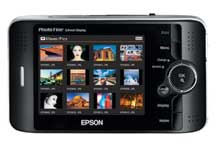
The Epson P-2000 may be the first truly practical and well-designed compact photo storage/viewer unit for photographer's on the go. As an added bonus, it supports movie and audio files.
It doesn't take long to fill up large flash cards on a long photo excursion. A laptop can be used to download memory cards, but even the smallest laptops take up too much space to carry "out in the field". My usual practice is to carry several 1 GB cards with me and download them to a laptop at night (and burn backups to CD-R discs).
Now it is possible to carry your portable hard drive and image viewer on your belt and download memory cards whenever you want. Previous portable units all had weaknesses of one sort or another. It looks like Epson is the first to get it right.
The Epson P-2000 is a 40 GB storage unit and viewer with a 3.8 inch color screen. The unit only measures 5.8 x 3.3 x 1.2 inches in size. It can download thirteen (13) 1 GB memory cards on one charge. That is a lot!
Just to keep this in perspective, on a two week trip to Tahiti, I shot 13.8 GB worth of photos. That is a total of 5,400 photos in jpeg/fine mode on a 6 megapixel Canon 10D camera. The Epson P-2000 would download almost all of those photos on one battery charge. The 40 GB capacity of the P-2000 means it would hold almost three times as many photos as I took on the entire Tahiti trip.
Charge the battery in the P-2000, put it on your belt, and set out with your camera gear and two memory cards. When one card card is full, put it into the P-2000 to download while you continue shooting with the other card. Alternate the memory cards and you can continue shooting this way all day long (unless you exceed 13 GB, then you will need to recharge the P-2000).
You can review jpeg files and some RAW files (Nikon NEF, Canon CRW and CR2, and Epson R-D1) on the 3.8 inch screen. It will store other kinds of RAW files but you can't view all of them.
It is still a good idea to download the files from the P-2000 to your laptop at night via the USB 2.0 connection on the P-2000.
The Epson P-2000 will store other kinds of files and supports several kinds of movie and audio files (including AVI, MOV, mpeg, m-jpeg, AP4, ASF, MP3, and AAC files).
Two good reviews are at DP Review and Luminous Landscape.
Total cost is around $500 (USD).
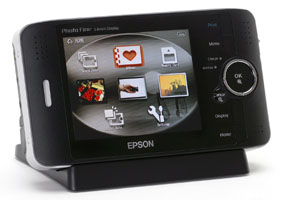
Wednesday, December 22, 2004
CANON 20D vs NIKON D70
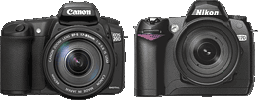
Every day people come to my primary website wanting to know which is the better camera, the Canon 20D or the Nikon D70. The answer for most people is that it doesn't matter. Let me explain why.
Both cameras are excellent digital cameras capable of taking excellent photographs. The differences in photos will have more to do with the eye and technique of the photographer, rather than any minor differences in the cameras. One camera does have an edge over the other, but I will get to that in a moment.
Whatever is the best camera of the moment will change in a few months to a year. The Canon 10D was the best camera in its class at the time of its introduction. The Nikon D70 gave it a run for its money when it came out, and some would say the Nikon D70 is better than the Canon 10D. Now the Canon 20D is available and many say it is better than the Nikon D70. So what!! Most folks can't afford to spend the rest of their lives buying the latest and greatest camera, much less switching lenses.
The more important question is "What lenses do you have or want to get?" Repeat after me: "LENSES ARE FOREVER AND BODIES ARE TEMPORARY." That is an obvious overstatement, but gets at something important. All of my lenses purchased over the last 20 years still work fine today. A set of well chosen lenses costs more than the camera body. For a long time, wise photographers have put their money in better glass rather than the very best film camera. This is even more true today as digital bodies are regularly replaced by a newer and usually improved versions. Choosing a good lens system is the number one priority. Then pick a camera that will use those lenses.
If you have a set of Canon EF lenses that you like and will continue to use, then your decision, if you are switching to digital, is to pick a Canon EOS digital body (or Kodak body) that you can put your Canon lenses on. Depending on cost and features, you can choose between the Canon Digital Rebel, the Canon 10D, the Canon 20D, one of the Canon 1D "pro" series bodies, or the Kodak DCS Pro SLR/c. The 20D is so feature rich and produces such high quality images that it is more than adequate for many professional uses. (A photographer for NATIONAL GEOGRAPHIC shot an article for the January 2005 issue using a pair of 10Ds.)
If you have a set of Nikon lenses that you like and want to continue to use, then your decision, if you are switching to digital, is to pick a camera body (Nikon, Fuji, or Kodak) that you can use with them. By all accounts, the Nikon D70 is an excellent choice.
The same applies to other brands of lenses, providing you have a digital body that you can use with your lenses.
If your lenses have been orphaned without a digital body available, then you are faced with starting over. Or maybe you don't have an SLR body and want to jump to digital, then you have some choices to make.
All of the major camera manufacturers offer good to excellent lenses, with some variations in quality within each of their own lens lines. Reviews can lead you to the better lenses in each brand. Some of the "aftermarket" lenses are quite good too.
I like Canon lenses for several reasons.
1) A good selection of IS (image stabilization) lenses. They allow me to hand hold photos at much slower shutter speeds than would otherwise be possible. Other manufacturers have lagged behind in this area.
2) Tilt-shift lenses in three focal lengths. Tilt-shift lenses allow me to tilt to extend depth-of-field, to shift for perspective control, to shift for creating easy to stitch panoramas, and to tilt and shift to play with perspective in creative ways.
3) A nice collection of macro lenses and accessories, including the specialized 65mm 1X-5x macro lens.
Your needs may be less specialized than mine and these feature may not be as important to you.
If you are switching to digital, your primary decison relates to lenses, your secondary decison relates to camera bodies.
When the Nikon D70 bested the competition, should Canon owners despair? No. Canon came back with the Canon 20D. Should Nikon owners despair?. No, Nikon will come out with an improved version. The important thing is that the folks with Nikon or Canon lenses have excellent camera bodies to use right now, and better ones will come out in the future.
So which camera is better? I only own one Nikon SLR body, and it is pre-autofocus, so I am not qualified to say. I can tell you that respected reviewers that have used both would give the nod to the Canon 20D as the better camera. DP Review, one of my two favorite review sites, calls it the best in its class.
You can find reviews of the 20D at DP Review, Luminous Landscape, Digital Camera Resource, Steve's Digicams, Imaging Resource, and Rob Galbraith.
My reviews of the Canon 10D are here and here.
Friday, December 17, 2004
Merry Christmas!

Ski Island. Oklahoma. Photo copyright (c) Jim Doty, Jr.
May the joys and blessings of this season be with you now and throughout the coming year.
COMPLETE COMPUTER SCAN
This is THE place to go to find the complete guide to scanning your system for viruses,trojans, spy-ware, mal-ware and other computer infections:
Major Geeks Support Forums
Wednesday, December 15, 2004
GREAT SLIDE SHOW SOFTWARE FOR THE WEB
I have been a big fan of Imagematics software for some time now. This will be a brief review since you can read the details about the products at the Imagematics website. My endorsement is very simple. It is my favorite software for taking still pictures and creating web ready "movies" and slide shows. Imagine the "Ken Burms" movie effect where the camera pans across the scene, but it is add done with still pictures. Or create photo albums online where the photos change like pages turning in a book.
I can use the Imagematics software to do full screen slide shows. I also use Swiff Player (a free download) to present flash (swf) shows as live, digital, full-screen movies and slide shows. All of the Imagematics software allows the use of soundtracks.
PE (Personal Edition) allows you to create slide shows which include your choice of several transitions between slides, plus pan and zoom effects. You can vary the length of each transition and how long each slide is displayed. It is very easy and fast to creat a show from a folder of images. Buttons allow you to quickly choose a transition for each slide, or you can quickly choose the same transition for every slide. I have created slide shows before a live audience by turning a folder of images into a live slide show in less than 2 minutes.You can add a soundtrack, as you can with all Imagematics software. You can output the show in several sizes, with different backgrounds and/or borders. Creating flash files for the internet is a whiz.
WD (Web Designer) takes all of the features of PE and adds the use of web link, interactive content and other web-valuable featrues.
SMC (Still Motion Creator) is remarkable software that allows all of the "Ken Burns" pan, zoom, and rotate effects. SMC is PE taken to the ultimate. To use the software, open an image and draw a square anythwere in the image you want the pan or zoom to begin. Then draw a second box where you want the pan or zoom to end. Use the time line to set the length of the pan/zoom effect. The time line is also where you set the length of transitions between images, how long an image is shown, and where you add sountracks. Check out both SMC movies below.
The software begins at around $50 for PE (less if there is a special going on).
Links to a few movies and slide shows I have created with this software are at the bottom of this page .
Imagematics website
Monday, December 13, 2004
PACKING LIGHT FOR TAHITI: LIVING WITH THE NEW AIRLINE TRAVEL RESTRICTIONS
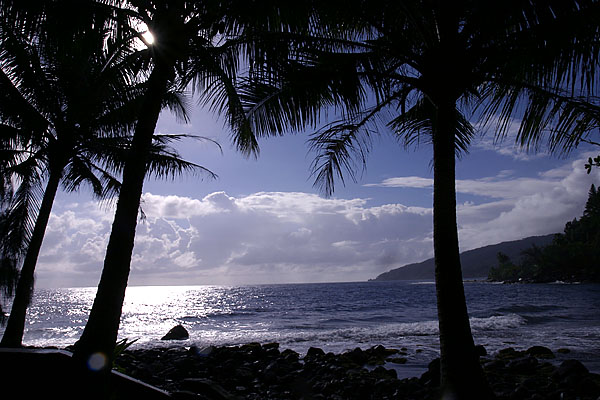
Tahiti Nui's northeast coast. Photo copyright (c) Jim Doty, Jr.
With a 10 kilogram weight limit (22 pounds), it was hard to carry all of my photo gear onto the plane to Tahiti. I had to make some hard choices.
Travel by airplane has been difficult for photographers ever since 9-11-2001. It has been an axiom for a long time to carry on all essential gear and film. The new x-ray machines that are used to scan checked luggage will definitely fry your film. Theft of camera gear in checked luggage has been a problem for a long time and is even more problematic with the new regulations and procedures that are in effect. Most or all checked luggage is being scanned and luggage must be unlocked (or locked with one of the new style locks that security people can open). I saw very little locked luggage on the baggage claim carousels after my recent flights. There are lots of stories of photographers that have had their gear stolen out of checked luggage.
To make matters worse, many (most?) insurance policies will not cover your camera gear if it is stolen or damamged while you are on a trip outside the U.S. Don't expect the airline to reimburse you for the value of your equipment. You check your photo gear at your own risk.
My rule of thumb for a long time has been "What will I need if my checked luggage is delayed or lost?" Before my most recent flights, my solution was simple when I was allowed two carry-ons, even for trans-Atlantic flights. I would pack one backpack and one rolling carry-on bag - both within the airline size and weight limits. Two camera bodies, lenses, essential meds, and as much film as I could stuff in would go in the camera backpack. My tripod, the rest of my film, a few clothes, and other essential items would go in the rolling carry-on. The film would be in a large, clear Zip-loc style bag. The rest of my clothes and everything else would go in a large checked bag. If for some reason I had to part with one of my two carry-ons, I would keep the backpack and take the film out of the rolling bag before turning it over to the airline. (If you haven't already heard, NEVER PUT FILM IN YOUR CHECKED LUGGAGE.) I never had to surrender a bag when I was using this system, but I was ready just in case. If an airline still allows two carry-ons plus laptop case, this is still what I do.
Most airlines now allow only one carry-on plus a laptop case. My packing system has changed too.
I still use the rolling bag which is the maximum carry-on size allowed. I also use a Lowepro Micro Trekker 200 camera backpack that fits inside the rolling bag. I pack my camera gear into the Lowepro backpack and put it inside the rolling bag. I put my tripod into the rolling bag next to the backpack. I put in other essential items, and one change of clothes. It is a tight fit. It all weighed in at 36 pounds, 4 pounds under the 40 pound carry-on limit it for my flight to LAX.
Since I have gone digital-only for trips by plane, I took a laptop, essential meds, and other accessories in the laptop case. Everything else went into one large checked bag.
That got me to LAX and it would work for air travel anywhere else in the U.S. If my checked bag was delayed or lost, I would have everything I needed except spare clothes and other items that are nice to have but I could live without or buy at my destination.
The challenge was to get to Tahiti on Air Tahiti Nui with their 10 kilogram weight limit for the one carry-on bag.
I re-packed my bags in Los Angeles. My rolling carry-on would become checked luggage. If my checked bags were delayed or lost, I would have my backpack with camera gear, laptop case with essentials, and the clothes I was wearing. I planned it all out at home and weighed everything.
My laptop case held an Apple iBook G4 laptop in one pocket (small and light). In the same pocket I put 24 CD-R discs in sleeves about the same size as the G4. Each sleeve held 8 CD-Rs discs. That would allow me to backup 16.8 gigabytes worth of photos. My custom is to transfer all photos each night to the laptop via a card reader and burn all files immediately to CD-R dics. YOU SHOULD ALWAYS HAVE YOUR DIGITAL FILES IN AT LEAST TWO PLACES. If your hard drive crashes (and it will eventually), you still have your CD-R dics.
In another pocket in my laptop case I carried the G4 power cable, mouse, compactflash card reader, outlet adapters and voltage converters for Tahiti (I didn't need the voltage converter but I used the outlet adapters all the time), essential meds, single use underwater cameras, Visor PDA, mobile phone, AAA and AA batteries, and other essential items.
With my digital backup needs and other essential items taken care of in my laptop case, the bigger challenge was my camera backpack.
The Lowepro Micro Trekker 200 is small but it can hold a lot of equipment. I packed two Canon 10D camera bodies and a Canon Powershot G3. For ordinary running around I carry one camera. On an important photo trip I take 2 bodies. Tahiti is a once in a lifetime trip, so I not only had two Canon 10Ds, I also had the Canon G3 in the unlikely event both Canon 10D's developed problems. The G3 also did double duty for recording low resolution digital movies that are suitable for web use.
I packed the following lenses, all Canon brand:
Canon EF 15mm semi fisheye
Canon EF 17-40mm f/4 L
Canon EF 28-135mm f/3.5-5.6 IS
Canon EF 70-300mm f/4.5-5.6 DO IS
For a long lenses I would usually take the Canon 70-200mm f/2.8 L lens and the Canon 100-400 IS lens plus teleconverters, but taking both was out of the question. Even taking one was pushing the weight limit and would mean leaving something else at home. Anticipating this problem, I acquired the new Canon EF 70-300 DO IS lens and tested it extensively this summer (see my SPEC 2004 albums at this site). The 70-300 DO proved to be a fine lens. It is not as razor sharp as the 70-200 f/2.8 lens (one of the sharpest lenses I own), but it is still plenty sharp. It is also much smaller and lighter than my usual long lenses due to the special DO formula. It is NOT compatible with Canon teleconverters. I really like this lens!
In the backpack I also carried five 1 GB compact flash memory cards (which I rotated), a Canon 550EX flash, 25mm extension tube, Canon 250D closeup filter, Singh-Ray polarizing filters, battery charger, 2 extra camera batteries, Tahiti electrical outlet adapter, electronic cable release, gray card, microfiber lens cleaning cloth, and a few other odds and ends.
Why five 1 GB cards? Without using the laptop and CD-R discs, five cards would hold 2000 photos as jpeg-fine files.
All of this inside the backpack weighed 21.6 pounds, just a little under my 22 pound weight limit for my carry-on.
The only thing I couldn't get into my backpack or laptop cased was my Gitzo carbon-fiber Mountaineer tripod and Bogen 3-way tripod head. Fortunately, one of my travel partners had room for it in their carry-on bag.
Did I miss anything? Sure! It would have been nice to have my 24mm tilt-shift lens for shifted panoramas, a macro lens with ring flash for ultimate quality closeups, a high-res video camera, and there were a few times I wished I had my 100-400mm lens, but I got by pretty well with what I had. If had to to live with the same size and weight limits again, I would pack the same gear. It served me quite well.
Two tips. Wear your most comfortble shoes on the plane. If your checked luggage with spare shoes goes astray, you will be glad you wore them. Buy the Lonely Planet travel guide for French Polynesia if that is your destination. It is the best.
You can see some of my Tahiti photos by scrolling down to the Tahiti albums here.
Saturday, December 11, 2004
CANON 1Ds Mark II
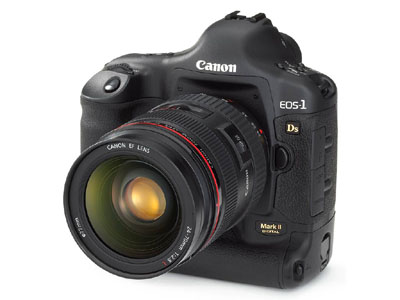
The recently announced Canon 1Ds Mark II is an extraordinary, 16+ megapixel camera with a 35mm sized imaging sensor. The January 2005 issue of POPULAR PHOTOGRAPHY magazine calls it "the new benchmark for image quality in a portable SLR". It exceeds the image quality of 35mm film and compares favorably with medium format film images. All of this for a mere $8,000. The price tag of course means this is only for the well-heeled pro or well-to-do serious amateur. The rest of us will just have to drool a little longer until digital SLRs with full frame sensors become more affordable. There is good news for the rest of us in the Canon 20D and Nikon D70, two excellent digital SLRs at a fraction of the price of the 1Ds Mark II. Other good cameras are out there and in the works.
Two of the best online sources of information about the 1Ds II are the preview at DP Review and the review at the Luminous Landscape. Hopefully, DP Review will have a full review posted soon.
|